Tyson Foods Bundle
How Does Tyson Foods Dominate the Food Industry?
From humble beginnings to a global powerhouse, Tyson Foods' journey is a masterclass in strategic evolution. Witness how this food industry giant has navigated consumer trends and market demands to become a household name. This article unveils the secrets behind Tyson Foods' sales and marketing prowess, revealing the tactics that have fueled its impressive growth.
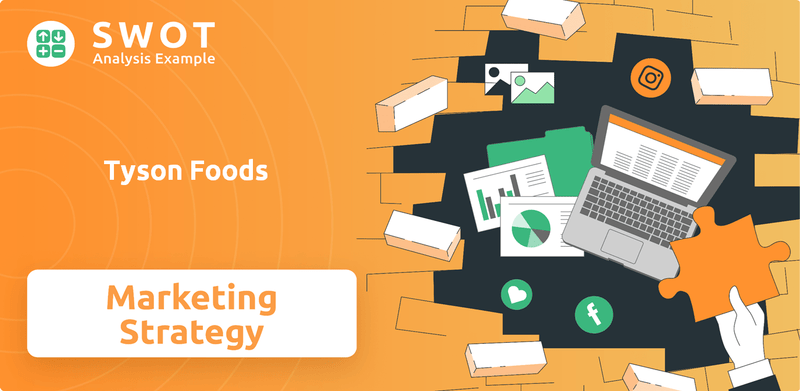
Tyson Foods' success story is a testament to its dynamic Tyson Foods SWOT Analysis, sales and marketing strategies. Understanding the company's approach to reaching its target market, from its distribution channels strategy to its innovative product offerings, is key. We'll explore how Tyson Foods' business model and competitive advantage are shaped by its marketing campaign examples and digital marketing initiatives, providing valuable insights for anyone interested in the food industry's strategic landscape. Discover how Tyson Foods' sales growth strategies and brand positioning strategy have solidified its place among its competitors.
How Does Tyson Foods Reach Its Customers?
The sales channels for the company are multifaceted, designed to reach a wide audience. The company's approach includes both traditional and modern methods to ensure its products are accessible to consumers and businesses alike. This strategy is essential for maintaining its market position and driving sales growth.
Historically, the company has relied on established channels like wholesale distributors and direct sales to foodservice operators. This includes restaurants, schools, and other institutions, which have been a significant part of the company’s business. In the retail sector, products are widely available in grocery stores and supermarkets worldwide. This broad distribution network is key to the company's success.
The evolution of the company's sales strategy has seen a shift towards digital adoption and omnichannel integration. While direct-to-consumer (DTC) e-commerce is not a primary channel for raw meat products due to logistical complexities, it has expanded its online presence through partnerships with major e-commerce platforms and online grocery delivery services. This allows consumers to purchase prepared foods and other packaged products conveniently. The company also leverages its strong relationships with partner retailers for exclusive distribution deals or promotional activities, contributing to market share and brand visibility.
Wholesale distributors and direct sales to foodservice operators are key channels. These channels cater to restaurants, schools, and other institutions, which are significant customers. This approach ensures that bulk meat products reach a wide range of businesses.
Retail partnerships are crucial for reaching consumers. Products are available in grocery stores and supermarkets globally. The company has established partnerships with major retail chains to ensure broad market penetration.
E-commerce and digital platforms are used for online sales. Partnerships with major e-commerce platforms and online grocery delivery services are in place. This channel focuses on prepared foods and packaged products.
Strategic partnerships enhance market share and brand visibility. Exclusive distribution deals and promotional activities with retailers are common. These partnerships contribute to overall sales growth and brand recognition.
The company continuously optimizes its sales channels. It focuses on data analytics to understand consumer purchasing habits and channel effectiveness. This data-driven approach helps the company adapt to market changes and improve its sales strategy.
- Data analysis is used to understand consumer behavior.
- Channel effectiveness is continuously monitored.
- Adaptation to market changes is a key focus.
- Sales strategies are improved based on data insights.
The company's sales strategy is designed to leverage multiple channels to maximize market reach. Its approach includes traditional wholesale and foodservice channels, retail partnerships, and an evolving digital presence. By focusing on data analytics and strategic partnerships, the company aims to optimize its sales performance and maintain a competitive edge. Understanding the Competitors Landscape of Tyson Foods is also crucial for refining its sales and marketing plan.
Tyson Foods SWOT Analysis
- Complete SWOT Breakdown
- Fully Customizable
- Editable in Excel & Word
- Professional Formatting
- Investor-Ready Format
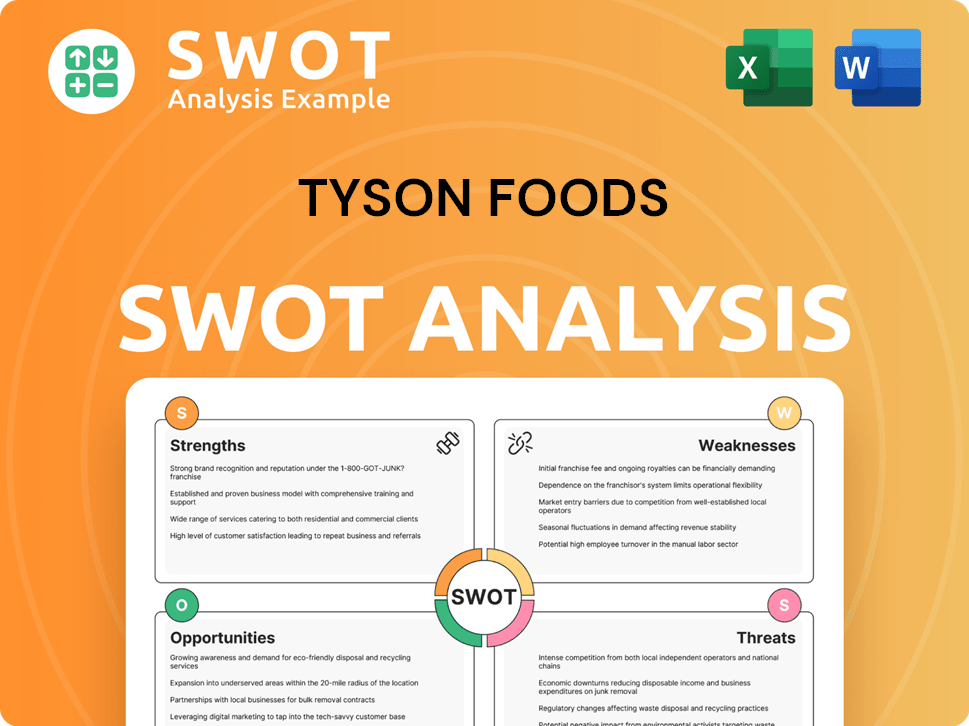
What Marketing Tactics Does Tyson Foods Use?
The marketing tactics employed by the company are multifaceted, designed to build brand awareness, generate leads, and ultimately drive sales across its extensive product lines. Their approach blends digital and traditional strategies, ensuring a broad reach to various consumer segments. This comprehensive strategy is crucial for maintaining market share and adapting to evolving consumer preferences in the competitive food industry.
Digital marketing is a key component of the company's strategy, utilizing content marketing, SEO, paid advertising, and email campaigns to engage consumers online. Social media platforms are actively used for brand storytelling and direct interaction. Traditional media, including TV commercials and print ads, also play a significant role in reaching a wider audience.
The company's marketing strategy is data-driven, employing customer segmentation and personalization to tailor messages and offers effectively. This approach allows for optimized marketing spend and a deeper understanding of consumer behavior. The integration of digital and traditional channels, with a focus on sustainability and convenience, reflects the company's adaptation to current market trends.
Content marketing, SEO, and paid advertising are central to the company's digital strategy. Email marketing and social media engagement further enhance their online presence, fostering consumer relationships. These initiatives are crucial for driving online sales and brand visibility.
TV commercials, radio ads, and print media in industry publications are still vital. Event participation and sponsorships also allow for direct consumer and industry professional engagement. This approach ensures a broad reach across various demographics.
Customer segmentation and personalization are used to tailor messages and offers, optimizing marketing spend. Advanced analytics tools track campaign performance and consumer behavior. This data-driven approach is key to their overall Revenue Streams & Business Model of Tyson Foods.
The company emphasizes sustainability messaging and convenience in its marketing efforts. This reflects current consumer preferences and market trends. These elements are increasingly important in the food industry.
Collaborations with influencers, particularly in the food and lifestyle sectors, are utilized. This strategy helps reach broader audiences and build credibility. Influencer marketing is an effective way to connect with consumers.
The marketing mix seamlessly integrates digital and traditional channels. This comprehensive approach is designed to maximize reach and impact. This integrated strategy supports the company's overall sales and marketing plan.
The company's marketing strategy includes a blend of digital and traditional tactics, leveraging data-driven insights for effective campaign optimization. This approach supports the overall
- Digital Marketing: Content marketing, SEO, paid advertising, and email marketing are key.
- Social Media: Active use of platforms like Facebook, Instagram, and TikTok.
- Traditional Media: TV commercials, radio ads, and print media.
- Events and Sponsorships: Participation in trade shows and culinary festivals.
- Data Analytics: Customer segmentation and personalization for tailored offers.
- Influencer Marketing: Collaborations with food and lifestyle influencers.
Tyson Foods PESTLE Analysis
- Covers All 6 PESTLE Categories
- No Research Needed – Save Hours of Work
- Built by Experts, Trusted by Consultants
- Instant Download, Ready to Use
- 100% Editable, Fully Customizable
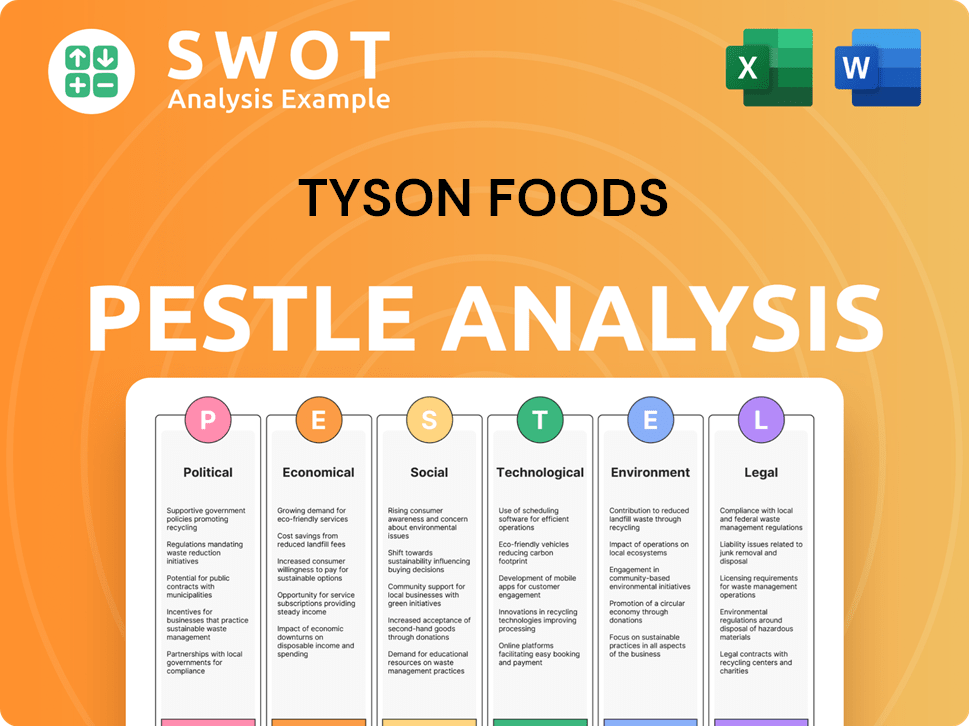
How Is Tyson Foods Positioned in the Market?
The brand positioning of [Company Name] centers on core values like quality, trust, and convenience, aiming to stand out in the competitive food industry. Their identity highlights their long-standing reputation as a dependable protein provider, emphasizing the safety and nutritional value of their products. This approach is crucial for their overall Tyson Foods sales strategy and Tyson Foods marketing strategy.
Visual branding often uses images of wholesome ingredients and family meals to evoke tradition and reliability. Marketing communications typically use an approachable, consumer-focused tone to connect with everyday households. This strategy is key to understanding Tyson Foods strategy and its impact on their Tyson Foods business model.
The company caters to a wide audience by offering diverse products, from raw meats to prepared meals. They increasingly emphasize sustainability and animal welfare to build a responsible brand image. This is part of their response to evolving consumer preferences, and it is a key element when considering Tyson Foods market analysis.
The company leverages its history to build trust. They emphasize the consistent quality and safety of their products. This builds a strong foundation for their Tyson Foods brand positioning strategy.
They offer a wide range of products to meet various consumer needs. This includes raw meats, prepared foods, and even plant-based options. This approach is critical to their Tyson Foods target market analysis.
The company is increasing its focus on sustainability and animal welfare. This aligns with changing consumer values and enhances their brand image. This is a key part of their long-term Tyson Foods sales and marketing plan.
They are adapting to market trends, such as the growing interest in plant-based alternatives. This demonstrates their ability to evolve while maintaining their core identity. This is crucial for their Tyson Foods competitive advantage.
The company aims for consistent branding across all channels. This includes packaging, digital ads, and in-store promotions, ensuring a unified brand experience. This strategy is essential for effective Tyson Foods advertising strategies.
They monitor brand perception and consumer feedback to identify areas for improvement. This helps them address any competitive threats or shifts in consumer preferences. This is vital for their Tyson Foods customer relationship management.
The company utilizes digital marketing to reach consumers. This includes social media and online advertising to promote products and engage with customers. This is an example of Tyson Foods digital marketing initiatives.
They integrate marketing with their supply chain to ensure product availability and freshness. This is essential for maintaining customer satisfaction and efficient operations. This is an example of their Tyson Foods supply chain marketing.
The company focuses on product innovation to meet evolving consumer demands. This includes new flavors, packaging, and product formats. This is part of their Tyson Foods product innovation strategy.
They use various Tyson Foods distribution channels strategy to ensure products reach consumers. This includes retail stores, online platforms, and food service providers. This is a key element in their overall strategy.
The company uses a strategic Tyson Foods pricing strategy to remain competitive. They also implement promotional campaigns to drive sales and increase brand awareness. The company's marketing efforts are crucial for their success.
- The company's revenue in fiscal year 2023 was approximately $52.8 billion.
- In 2024, the company continues to adapt to changing consumer preferences.
- The company's focus on sustainability and animal welfare is growing.
- The company's marketing campaigns aim to increase brand awareness.
For more information about the company's origins, check out this Brief History of Tyson Foods.
Tyson Foods Business Model Canvas
- Complete 9-Block Business Model Canvas
- Effortlessly Communicate Your Business Strategy
- Investor-Ready BMC Format
- 100% Editable and Customizable
- Clear and Structured Layout
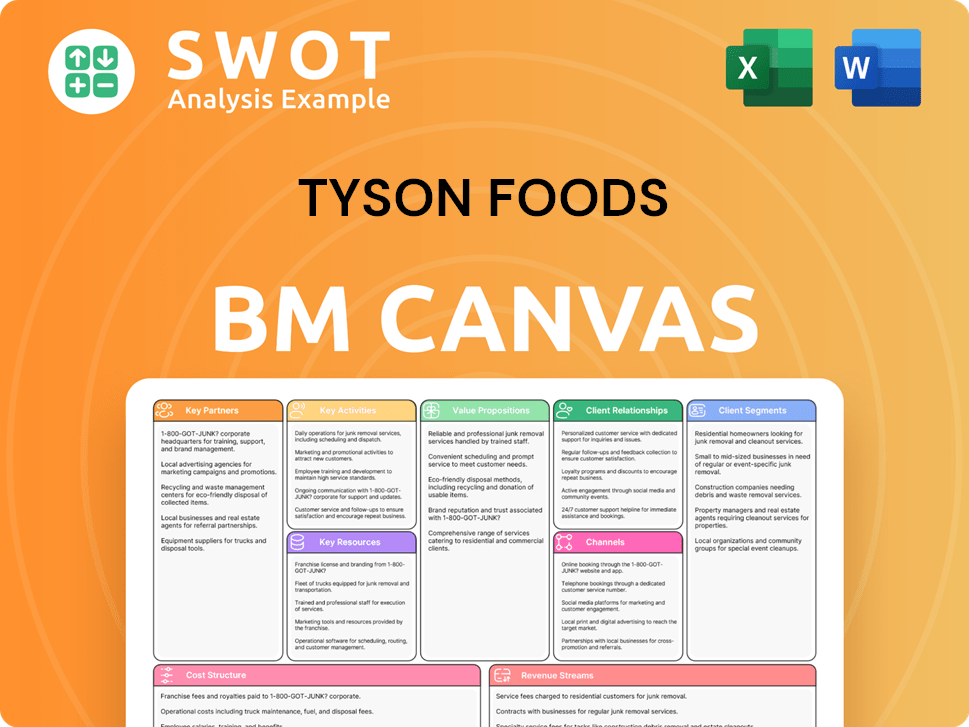
What Are Tyson Foods’s Most Notable Campaigns?
Understanding the Tyson Foods sales strategy and Tyson Foods marketing strategy involves examining key campaigns that have shaped its brand and driven growth. These campaigns are crucial components of the company's broader Tyson Foods strategy, designed to connect with consumers and maintain market leadership. While specific details of each campaign are proprietary, their impact on brand awareness, sales, and consumer engagement is significant.
Historically, marketing efforts have centered on the versatility and quality of core meat products, often incorporating recipes and meal solutions to provide value to consumers. More recently, there has been a shift to campaigns that highlight convenience, health, and sustainability, reflecting evolving consumer preferences. These campaigns are essential to the company's ability to adapt to market changes and maintain a competitive edge in the food industry.
The company's approach also includes collaborations, such as partnerships with celebrity chefs and food influencers, to boost brand visibility. These partnerships are particularly important for new product launches, helping to reach younger, digitally-savvy audiences. The company continuously analyzes campaign performance to refine strategies and learn from both successes and challenges. For a deeper dive into the ownership and financial structure, consider exploring Owners & Shareholders of Tyson Foods.
Early campaigns emphasized the quality and versatility of meat products. These campaigns often featured recipes and meal ideas to provide added value. This approach helped establish the company as a trusted source for quality food products.
More recent campaigns highlight the convenience of prepared foods. These campaigns target busy consumers looking for quick and easy meal solutions. This strategy aligns with the growing demand for convenience in the food market.
The company has also incorporated sustainability into its marketing efforts. This includes promoting sustainable sourcing practices and environmentally friendly packaging. This approach appeals to consumers who are increasingly concerned about environmental issues.
Digital marketing plays a key role, with the company utilizing social media and online advertising. This allows for targeted campaigns and direct engagement with consumers. The company's digital presence is crucial for reaching younger demographics.
The company often partners with celebrity chefs and food influencers. These collaborations boost brand visibility and credibility, especially for new product launches. This strategy helps connect with a younger, digitally-native audience.
The company continuously analyzes campaign performance. This includes tracking brand awareness, sales lift, and digital engagement metrics. This data-driven approach helps refine future marketing strategies.
Crisis management campaigns focus on transparent communication. This is particularly important during supply chain issues or public health concerns. Rebuilding consumer trust is a key objective.
The company's marketing often supports new product launches. This includes highlighting innovative products that meet changing consumer needs. Innovation is a key driver of growth.
Advertising campaigns are often targeted towards specific demographics. This allows for more effective messaging and higher engagement rates. The company uses data to understand consumer preferences.
The company focuses on building consumer engagement across various platforms. This includes interactive content, contests, and social media interactions. Strong engagement drives brand loyalty.
Tyson Foods Porter's Five Forces Analysis
- Covers All 5 Competitive Forces in Detail
- Structured for Consultants, Students, and Founders
- 100% Editable in Microsoft Word & Excel
- Instant Digital Download – Use Immediately
- Compatible with Mac & PC – Fully Unlocked
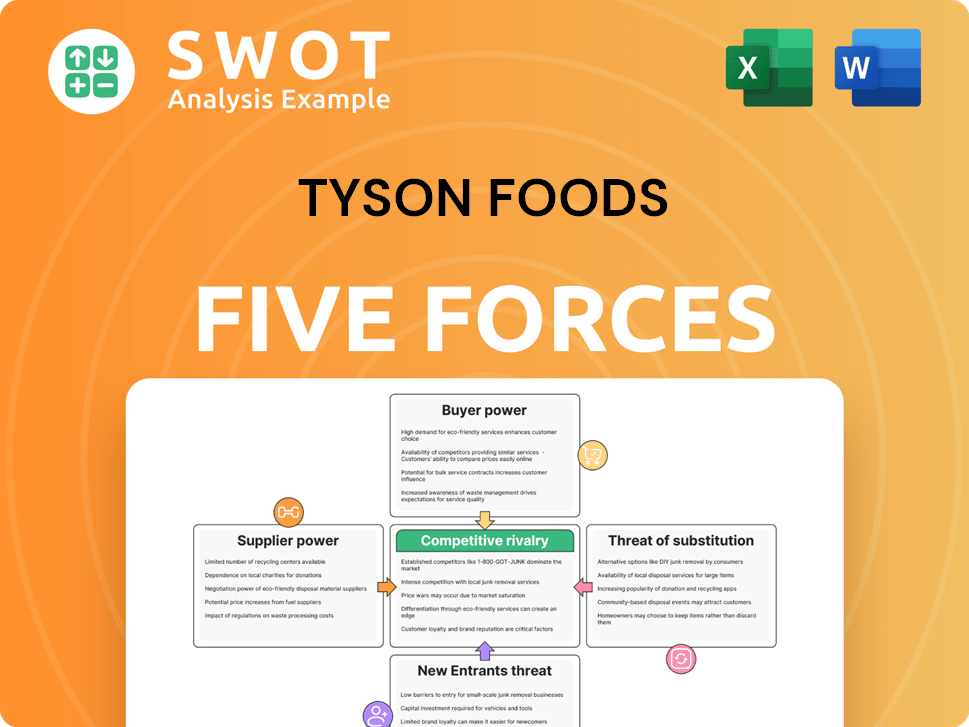
Related Blogs
- What are Mission Vision & Core Values of Tyson Foods Company?
- What is Competitive Landscape of Tyson Foods Company?
- What is Growth Strategy and Future Prospects of Tyson Foods Company?
- How Does Tyson Foods Company Work?
- What is Brief History of Tyson Foods Company?
- Who Owns Tyson Foods Company?
- What is Customer Demographics and Target Market of Tyson Foods Company?
Disclaimer
All information, articles, and product details provided on this website are for general informational and educational purposes only. We do not claim any ownership over, nor do we intend to infringe upon, any trademarks, copyrights, logos, brand names, or other intellectual property mentioned or depicted on this site. Such intellectual property remains the property of its respective owners, and any references here are made solely for identification or informational purposes, without implying any affiliation, endorsement, or partnership.
We make no representations or warranties, express or implied, regarding the accuracy, completeness, or suitability of any content or products presented. Nothing on this website should be construed as legal, tax, investment, financial, medical, or other professional advice. In addition, no part of this site—including articles or product references—constitutes a solicitation, recommendation, endorsement, advertisement, or offer to buy or sell any securities, franchises, or other financial instruments, particularly in jurisdictions where such activity would be unlawful.
All content is of a general nature and may not address the specific circumstances of any individual or entity. It is not a substitute for professional advice or services. Any actions you take based on the information provided here are strictly at your own risk. You accept full responsibility for any decisions or outcomes arising from your use of this website and agree to release us from any liability in connection with your use of, or reliance upon, the content or products found herein.